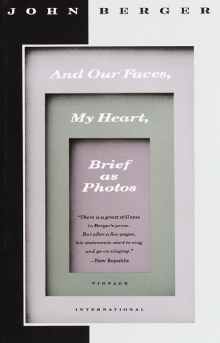20.1 John Berger

JOHN
BERGER
John Berger (b. 1926), like few other art critics, elicits strong and contradictory reactions to his writing. He has been called (sometimes in the same review) “preposterous” as well as “stimulating,” “pompous” yet “exciting.” He has been accused of falling prey to “ideological excesses” and of being a victim of his own “lack of objectivity,” but he has been praised for his “scrupulous” and “cogent” observations on art and culture. He is one of Europe’s most influential Marxist critics, yet his work has been heralded and damned by leftists and conservatives alike. Although Berger’s work speaks powerfully, its tone is quiet, thoughtful, measured. According to the poet and critic Peter Schjeldahl, “The most mysterious element in Mr. Berger’s criticism has always been the personality of the critic himself, a man of strenuous conviction so loath to bully that even his most provocative arguments sit feather-light on the mind.”
The first selection is Chapter 1 from Ways of Seeing, a book which began as a series on BBC television. In fact, the show was a forerunner of those encyclopedic television series later popular on public television stations in the United States: Civilization, The Ascent of Man, Cosmos, The Civil War. You can watch the first episode of that series here. Berger’s show was less glittery and ambitious, but in its way it was more serious in its claims to be educational. As you watched the screen, you saw a series of images (like those in the following text). These were sometimes presented with commentary, but sometimes in silence, so that you constantly saw one image in the context of another — for example, classic presentations of women in oil paintings interspersed with images of women from contemporary art, advertising, movies, and “men’s magazines.” The goal of the exercise, according to Berger, was to “start a process of questioning,” to focus his viewer’s attention not on a single painting in isolation but on “ways of seeing” in general, on the ways we have learned to look at and understand the images that surround us, and on the culture that teaches us to see things as we do. The method of Ways of Seeing, a book of art history, was used by Berger in another book, A Seventh Man, to document the situation of the migrant worker in Europe.
After the chapter from Ways of Seeing, we have added two brief passages from a beautiful, slight, and quite compelling book by Berger, And Our Faces, My Heart, Brief as Photos. This book is both a meditation on time and space and a long love letter (if you can imagine such a combination!). At several points in the book, Berger turns his (and his reader’s) attention to paintings. We have included two instances, his descriptions of Rembrandt’s Woman in Bed and Caravaggio’s The Calling of St. Matthew (and we have included reproductions of the paintings). We offer these as supplements to Ways of Seeing, as additional examples of how a writer turns images into words and brings the present to the past.

Berger has written poems, novels, essays, and film scripts, including The Success and Failure of Picasso (1965), A Fortunate Man (1967), G. (1971), and About Looking (1980). He lived and worked in England for years, but he currently lives in Quincy, a small peasant village in Haute-Savoie, France, where he wrote, over the course of several years, a trilogy of books on peasant life, titled Into Their Labours. The first book in the series, Pig Earth (1979), is a collection of essays, poems, and stories set in Haute-Savoie. The second, Once in Europa (1987), consists of five peasant tales that take love as their subject. The third and final book in the trilogy, Lilac and Flag: An Old Wives’ Tale of the City (1990), is a novel about the migration of peasants to the city. His most recent books include two essay collections, The Shape of the Pocket (2001) and Selected Essays (2001); Here Is Where We Meet: A Fiction (2005), a series of autobiographical vignettes; Hold Everything Dear: Dispatches on Survival and Resistance (2007), a meditation on political resistance; Why Looks at Animals (2009), essays on the relationship between humans and animals; and Bento’s Sketchbook (2011), a meditation on the practice of drawing.